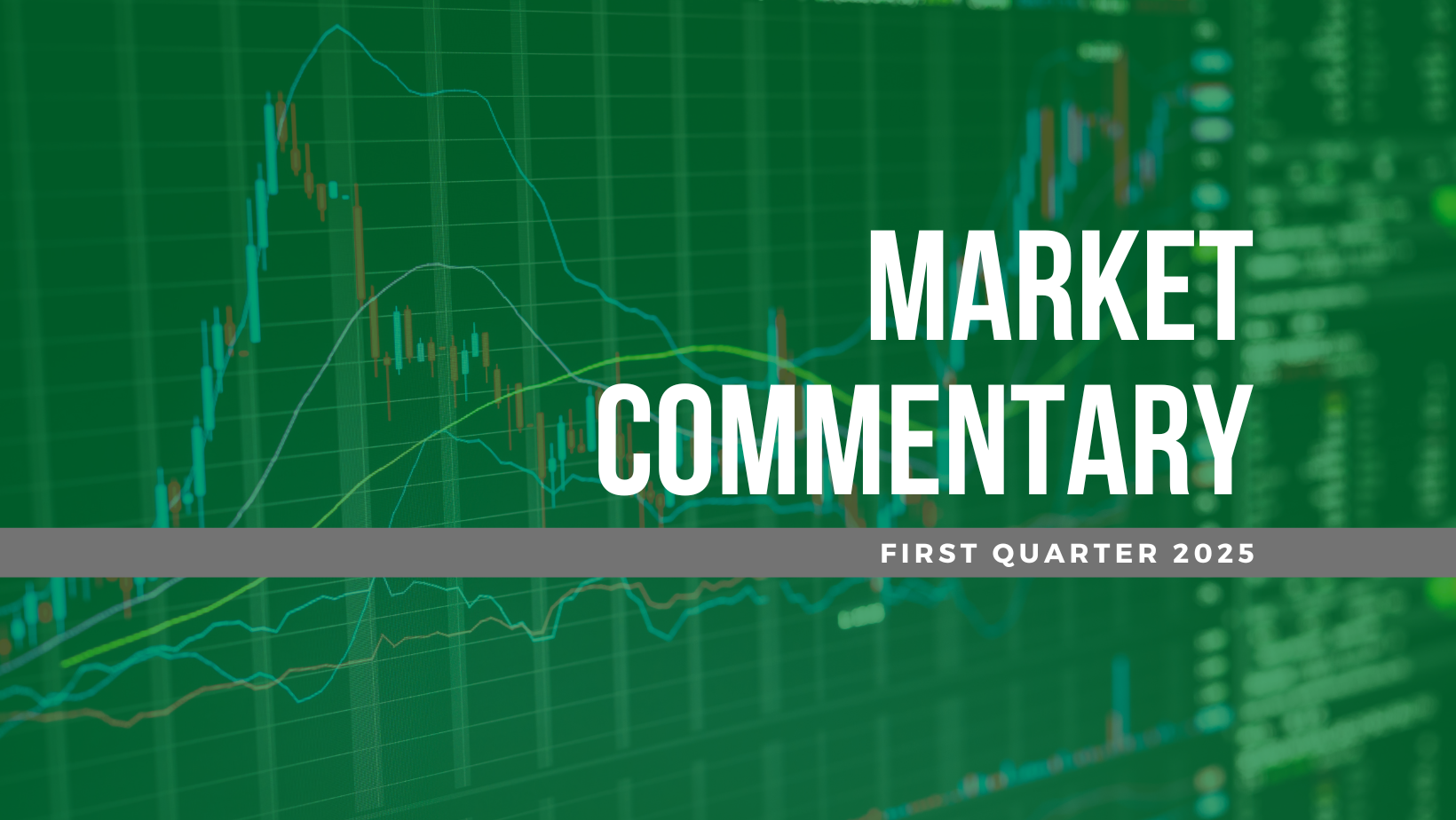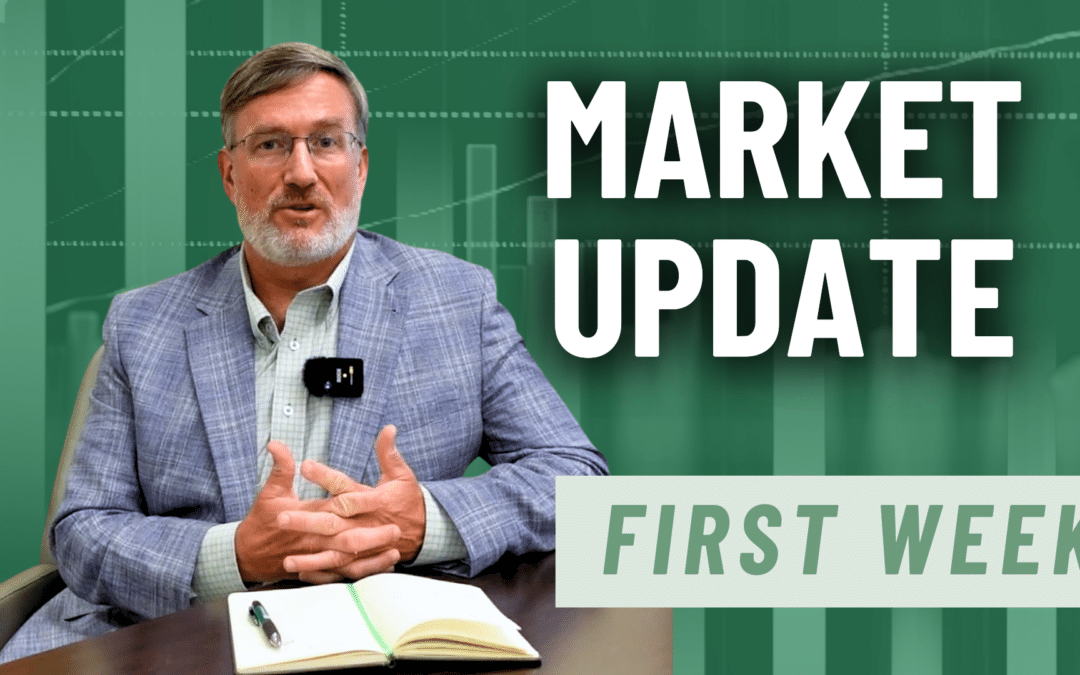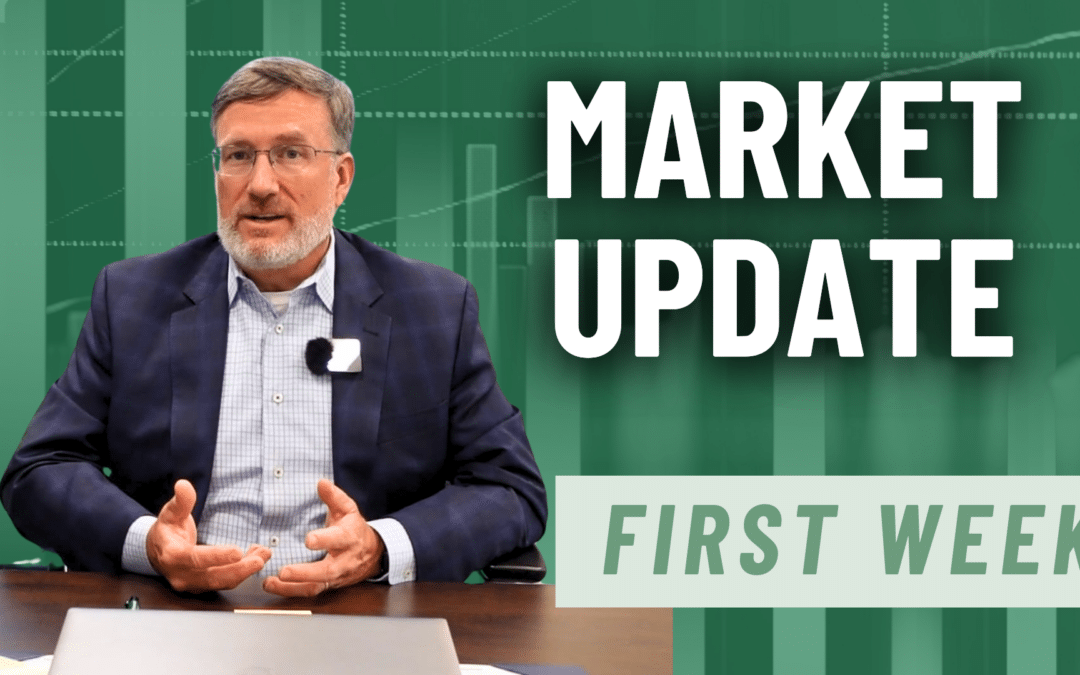Economic Overview
By Dr. Mark Pyles
Things often have a funny way of working out. Sometimes when you start to feel as though you can relax, the long-dreaded event finally starts to materialize. This happens often in everyday life, but it also pertains to economic data. As a backdrop theme of this commentary, we must remember that we are a consumer-driven economy. And the consumer is, in turn, largely driven by sentiment. We entered 2025 with an optimistic set of data upon which to build an opinion of the US economy. In the recently released final estimate for Q4 2024 GDP, we found that the US economy grew at a very robust rate of 2.4% quarter-over quarter annualized. This added to the 1.6%, 3.0%, and 3.1% values for the first three quarters of the year put the final touches on a solid year of domestic economic growth.
An Optimistic Start
We did exit 2024 with inflation stubbornly stuck above desired levels; the consumer price index (CPI) headline value was at 2.89% for December. Yet, fears of a reversal to meaningfully higher levels were relatively contained. Finally, the labor market reports of both November and December positively surprised the market, reaffirming the belief that consumers were, in aggregate, comfortably employed. And, perhaps the most dramatic tailwind (albeit in hindsight only a brief one) came with the unexpected election results in November. Spurred by the belief that the country had elected a pro-business administration set on deregulation and stimulating activity, markets rolled to an exceptional year-ending return.
Thus, we could all be forgiven for allowing a bit of complacency to enter our mindsets. However, hidden behind all of this was stubbornly pessimistic sentiment that, perhaps a bit too lackadaisically, was discarded as political noise. And now, what was already a gloomy trend has fallen into a tsunami of negative emotions throughout Q1 2025. As one of the most-watched estimates of sentiment, the University of Michigan monthly survey has declined from 74 in December to 57 as of the final March reading. This latter number is the lowest since the middle of 2022, and before that you must go back over a decade to get that low of a reading. The driving force of this downturn is a combination of very low expectations and increasing fears of higher inflation.
Worrying Reports
The long-standing and highly respected IMI PMI (Purchasing Managers Index) surveys also show troubling trends on a less politically biased platform. The manufacturing version had finally regained expansion territory above 50 in January for the first time since late 2022, but the fresh print from March pulled it back down into contraction territory again. When combined with the Conference Board expectations reading in February that declined all the way from 100 to under 93 and a litany of regional Fed surveys confirming the negative sentiment – there is little doubt that we are in a period of considerable pessimism. To be fair, we have long been in the camp that perhaps there are too many surveys, and they often are coincidental indicators at best, rather than leading. When this is combined with questionable response rates and a general decline in the correlation between sentiment and hard data, we have always been hesitant to use these as a driving force in making investment decisions.
However, in this current quarter, we have started to see cracks in the hard data that suggest the negative sentiment is beginning to leak over into tactile influences. For example, real personal spending was negative in January for the first time since March of 2023. February’s release was better, but still below bounce-back expectations at only 0.4%. Retail sales figures, which seemingly beat expectations each month over the last several years, have significantly underperformed expectations in each of the three readouts received this year (for December, January, and February data). These are just two examples of consumer-centric softening data that has led to considerable uncertainty surrounding growth for Q1 and the rest of the year. While estimates vary significantly, it seems it will be a close call between positive or negative real GDP growth for the quarter that just ended.
Tariff Wars
So where is all this about face coming from? The most obvious answer – and I imagine it’s a surprise to have gotten this far without seeing the word yet … is tariffs. Most – admittedly including us – did not expect the tariff wars to carry on as long and as arduously as they have to this point. As this goes to print, we are approaching what President Trump has labeled “liberation day,” where we are supposedly going to get further clarity on the plan. There will then of course be a litany of responses from other countries that must be waded through to balance exactly how much and to what extent these tariffs are going to influence economic activity. Clearly, the details are very murky at this point, and it is also very unclear to what degree, and for how long, these effects will persist even once initially determined.
During a recent internal meeting with our advisors, we were asked what hard data would truly make us nervous. The answer to that is almost always the same. We view the first domino to be the labor market. As long as consumers have jobs, are comfortable in the security of those jobs, and are getting compensation increases that allow them to maintain purchasing power, there is considerable evidence that American consumers will continue to spend. As a result, companies will be able to continue to drive margins, and the economy will continue to grow at a robust pace. We will receive the March employment report this Friday, April 5th. Expectation for nonfarm payrolls remains solid, at just under 140,000 at the time of this writing. We feel the true tell could be in the household survey, and the resulting unemployment rate. We are also paying close attention to the weekly jobless claim numbers as a high frequency indicator of this first domino effect. Any average level above 250,000 on a rolling basis would start to get our attention in a meaningful way.
Uncertainty is the New Norm
It is somewhat ironic to write this commentary understanding that by the time it is widely distributed and read, we will have received two monumental data events (“liberation day” for tariffs and the jobs report) that may serve to change nearly the entire tone. The irony is amplified by the most recent Fed meeting a few weeks back, where Chair Powell during his Q&A session made the word “uncertainty” the focal point and key takeaway. Both they, and all market participants, are juggling the potential impacts of exogenous influences that are seemingly changing shapes and forms daily. And in the modern world, information is conveyed at a lightning speed which heavily swings momentum much quicker than in times past.
Ultimately, should the uncertain nature of these events continue to worsen, consumers are likely to pull back on spending while firms are likely to pull back on investment. On the other hand, positioning and general sentiment is currently stretched significantly in a pessimistic direction. This equally has the potential to create a whiplash movement back to growth and gains in the event of any “relief outcome.” We urge investors to look for the tides instead of the waves. There are many waves, each seemingly larger than the last, that are beating all around. However, tides shift much more slowly. It is moving, and we admit not in a positive direction at current. However, with a prudent and disciplined perspective, we continue to feel that the base case for the U.S. economy is to bend but not break.
The Stock Market
By Walter Todd
Well, the theme of “March Madness” from the NCAA basketball tournaments seems completely appropriate for the stock market to start 2025. The difference is, while we have four #1 seeds in the Final Four of the men’s tournament (for the first time since 2008), what would be considered the top seeds for stocks based on 2023 and 2024 performance, the so-called Magnificent 7, have not shown up in 2025. In fact, they have done the equivalent of losing in the first round and finished down an average of over 15% through the first three months of the year. These results, as well as many other factors we will discuss, have resulted in the start to this year looking like a mirror image of the prior two years in terms of leadership. Let’s take a deeper dive into the numbers.
The S&P 500 finished down -4.3% for the quarter, including dividends. Looking beyond the US large-cap space, small-cap stocks (as measured by the S&P 600) faded hard after an initial rally in January to fall -8.9% for the three-month period. Performance outside the US was one of the most dramatic turnarounds from prior years. After a very weak finish in the fourth quarter of 2024, Developed International Markets rose 7.0% for the quarter (as measured by the EAFE Index) while Emerging Markets (EM) posted a gain of 3.0% for the period (measured by the MSCI Emerging Market Index). Putting the US and International Markets together, the MSCI All- Country World Index (ACWI) finished down slightly -1.2% for the quarter.
From a sector perspective, 7 of 11 sectors were actually positive for the period and 8 of 11 outperformed the broader market (S&P 500). Unfortunately, the three that underperformed accounted for roughly 50% of the market weight to start the year. As a result, sector leadership was flipped on its head from the prior two years, with Consumer Discretionary (-13.8%), Technology (-12.7%) and Communication Services (-6.2%) finishing at the bottom. Perhaps an overdue correction for these areas after combining to be the only three sectors to outperform the broader market over the past two years combined. The Energy sector (+10.2%) rose from the bottom (like a 16 seed beating a 1) to finish first. It was followed by Healthcare (+6.5%), Consumer Staples (+5.2%) and Utilities (+4.9%), all more defensive areas of the market. Real Estate (+3.6%) and Financials (+3.5%) also fared well with falling interest rates while Gold’s rally helped Materials (+2.8%) end in the green. This sector performance backdrop also helps explain the US vs. ex. US performance for the period as markets outside the US have much less exposure to the bottom performing sectors like Technology and more exposure to Energy and Financials which did relatively well.
The first three months of 2025 have felt like a year (or more) to me, with a variety of headlines and headwinds to choose from to explain some of the challenges for equities. Technology and the AI trade that had been so powerful in 2023 and 2024 took a hit in late January on the DeepSeek headlines from China, then the tariff “wars” started in February, and finally softer economic data in March proved to be the tipping point to create a bull market in uncertainty and pessimism among investors. The result was the worst month for S&P 500 (-5.6% in March) since 2022. From a factor performance standpoint, this cautious backdrop resulted in outperformance in areas like Dividends and Value, while Growth and Volatility were negative.
When looking at our strategies, these dynamics produced a positive absolute return in our Dividend Income portfolios and a relative performance win for our Large-cap strategy. SMID (small and mid-cap) was hampered by the asset class return and more exposure to Growth. Our International ETF portfolio performed in-line with the positive returns outside the US. Unlike the basketball tournaments which are about to conclude shortly, we still have nine more months in this calendar year. Still plenty of time for some leadership changes to occur yet again. Our sense is that the domination we saw from the top of market (kind of like UCLA 10 titles in 12 seasons from 64 to 75) is not likely to return in that form, resulting in a more balanced market.
While stocks overall are oversold and appear ripe for bounce in the short-term, we expect the volatility in the market to remain until we get more clarity on the path forward for policy and the economy. Similar to what you and I would do on foggy night driving a car, drive slower, businesses and consumers are being more cautious as driving conditions have become more uncertain.
The Bond Market
By John Wiseman
Fixed income markets rallied to start 2025 as investors sought safety from declining US equity markets and aimed to lock-in rates ahead of a Federal Reserve (“Fed”) on the cusp of resuming its rate-cutting cycle. Economic releases, especially surveys or so-called soft data, have been weak and even though inflation readings remain above preferred levels, the Fed has clearly shifted focus to the uncertainty of economic growth. At its most recent meeting, the Fed slowed the pace at which it is reducing its balance sheet. That is, it will reinvest more of its maturing Treasury bonds. The 10-Year Treasury Note finished the quarter with a yield of 4.21%, which is the same level from one year ago, but 36 basis points lower since the start of the year and equates to a total return of 4.01%. The yield on the 2-Year Treasury Note also moved lower by 36 basis points during the first quarter to 3.88% producing a total return of 1.56%. However, unlike the 10-Year, it is much lower (74 basis points) than the level one year ago. This has resulted in a yield curve that is positive (longer rates higher than shorter rates) and at its steepest levels in three years as measured by these two points. Very short Treasury Bills remain tied to the higher Federal Reserve rate. Concern over the level of US debt and forecasted fiscal deficits remain high, but refinancings through the normal Treasury Auction process continue to operate smoothly and demand remains strong.
Despite a challenging March, the corporate bond sector performed just slightly behind its Treasury counterpart for the quarter. The total return, as measured by the Bloomberg Intermediate Corporate Index, was 2.27%. Corporate bond spreads – the amount of yield over Treasuries that investors are compensated for assuming company specific risk – moved higher off of historically narrow levels in the first quarter. The spread of the Bloomberg Intermediate Corporate Index is at 83 basis points over Treasury yields – 12 higher than the start of the year. This was offset by the move lower in underlying Treasury yields producing a total return of 2.27%. Corporate bond issuance continued its robust pace as companies refinance debt that was issued around the pandemic. There was not much differentiation in returns among the large industry groups. There was significant weakness in the high-yield sector. A negative return in the month of March led this area to underperform investment-grade bonds by 1225 basis points. Continued weakness should provide opportunities to add back some exposure in this sector though we will stay in the higher-rated areas.
Municipal bonds yields didn’t participate in the recent strength of other fixed income securities making it the poorest performing area. The Bloomberg 5-Year Municipal Index ended the quarterly period with a total return of 0.91%. Municipal yields are unchanged since the beginning of the year even as Treasury yields are significantly lower. This has resulted in a ratio of 73% (a measure of relative value) when combined with the absolute yield level, which provides an attractive entry point. It is important to stay higher in quality as state and local governments have lost the windfall associated with the pandemic. Tax receipts should be healthy to start the year given the robust business climate and stock market gains of 2024, but the outlook is for lower revenue and reduced federal support.
Last quarter, we wrote about our efforts to increase portfolio duration given the overall level of rates. With the sharp rally in bonds to start the year, there will probably be better timing to continue this effort, and we are comfortable with our positioning. Additionally, we reduced our corporate bond exposure. We remain overweight this sector (as will most likely always be the case), but to a lesser degree and we remain positioned in higher quality companies.
The information contained within has been obtained from sources believed to be reliable but cannot be guaranteed for accuracy. The opinions expressed are subject to change from time to time and do not constitute a recommendation to purchase or sell any security nor to engage in any particular investment strategy. Investment Advisory Services are offered through Greenwood Capital Associates, LLC, an SEC-registered investment advisor.










